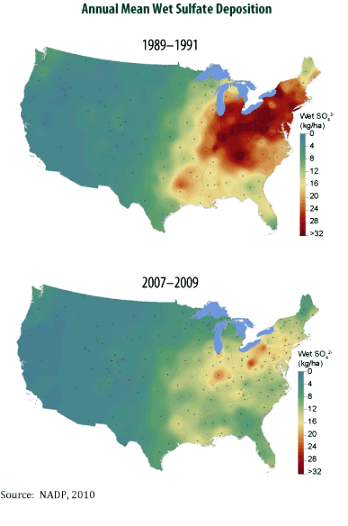There they go again. Economic meltdown. Higher consumer costs. Massive job losses. These are among the predictions of doom surrounding EPA’s current and forthcoming round of clean air protections. If they sound familiar, they should. Time and again, from the enactment of the Clean Air Act in 1970 to today, prophets of doom have predicted that disastrous consequences would flow from cleaning the air we all breathe. And time and again, those dire predictions have been wrong. The Clean Air Act has protected American health and our environment for decades while our economy has grown. It is a legislative success story that continues today.
This series will examine what the naysayers have said about Clean Air Act protections and how those wild predictions compare to the statute’s actual record of protecting Americans from toxic air pollution and its devastating effects on human health and the environment. We start with the acid rain program in the Clean Air Act Amendments of 1990.
Part One: The Acid Rain Program

These maps compare annual wet sulfate deposition at the time of the 1990 Clean Air Act Amendments and today's deposition levels, depicting the extraordinary progress that has been made. Source: NADP data.
Predictions of Doom
Twenty years ago, and twenty years after enacting the modern Clean Air Act, Congress took up the matter of acid rain, which was devastating ecosystems across the East and Northeast. Acid rain is caused by air pollution including sulfur dioxide emissions from coal-fired power plants. For the first time ever, the Clean Air Act Amendments of 1990 used the groundbreaking tool of a market-based cap and trade system to reduce sulfur dioxide emissions.
Industry fought the acid rain program with scare tactics throughout the legislative debate, warning that it would wreak havoc on the economy:
- The Edison Electric Institute predicted the Clean Air Act Amendments would cost the electric utility industry up to $4.5 billion a year.
- The Business Roundtable projected the total economic cost would be $104 billion a year.
- American Electric Power Company warned of “the potential destruction of the Midwest economy.”
- In an editorial that dismissed the scientific case for reducing acid rain, the Atlanta Journal and Constitution warned that “Americans can expect their power bills to skyrocket for nothing.”
Protecting our Health and Environment
Twenty years later, peer-reviewed EPA studies required by the Clean Air Act show that sweeping public health benefits have resulted from the reductions in air pollution achieved under the 1990 Clean Air Act Amendments. While the legislative debate about acid rain focused on environmental harm, public health reaped great benefits because sulfur dioxide pollution from power plants forms not only acid rain, but also particulate pollution that is particularly dangerous to breathe.
EPA estimates that the pollution reductions achieved under the 1990 Clean Air Act Amendments will in this year alone:
- Save 160,000 lives,
- Avoid 130,000 cases of acute bronchitis and 130,000 heart attacks,
- Prevent 86,000 emergency room visits,
- Keep children in school and prevent 3,200,000 lost school days and
- Keep workers on the job and prevent 13,000,000 lost work days.
These profound public health benefits are paired with dramatic reductions in sulfate deposition, and damaged environments have begun to recover from the ill effects of decades of acid rain.
Costs and Benefits
Not surprisingly, the cost of achieving the tremendous public health and environmental benefits of the Clean Air Act Amendments of 1990 were a fraction of industry forecasts, and significantly below EPA’s own projections. In 1990, power companies predicted that reducing sulfur dioxide pollution would cost $1000-$1500 per ton and electricity prices would increase up to 10% in many states (Factsheet, Committee on Energy and Commerce, Industry Claims About the Costs of the Clean Air Act [PDF], June 16, 2009). In fact, the actual pollution reduction cost has been between $100 and $200 per ton for most of the program, and electricity prices fell in most states. Acid rain has been dramatically reduced and the limits on sulfur dioxide pollution were met faster and at a strikingly lower price than anyone expected in 1990.
The benefits to public health and the environment outweigh these costs many times over. EPA’s analysis of the costs and benefits of the Clean Air Act projects that in 2020 the benefits of the 1990 Clean Air Act Amendments will exceed the costs of compliance by a factor of 30 to 1. Studies by the Office of Management and Budget and private researchers support these conclusions as well.
The predictions of doom in 1990 overlooked the power of American innovation unleashed by the goals of the Clean Air Act Amendments and the market-based system Congress established to achieve them. Unlike previous programs that specified what pollution controls must be used, the acid rain program set enforceable and descending limits on total pollution, but let industry experiment, innovate and find the most cost-effective means to lower pollution. These results are a striking rebuke to the critics who said it could not be done.










 This post is by
This post is by  This post is by
This post is by